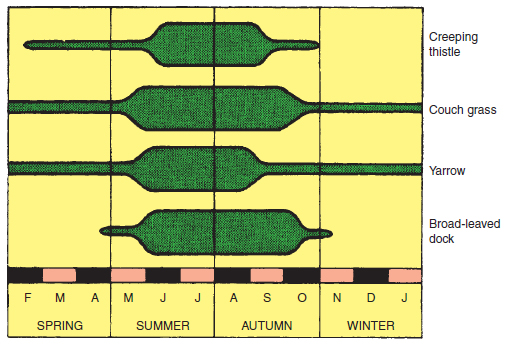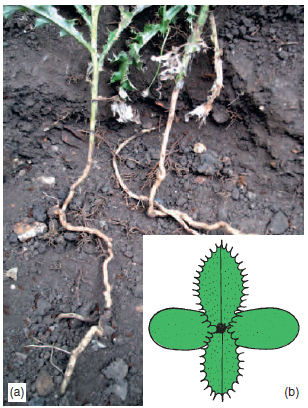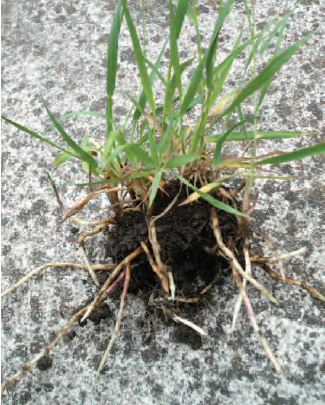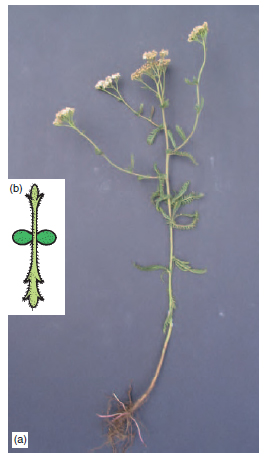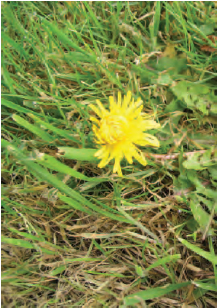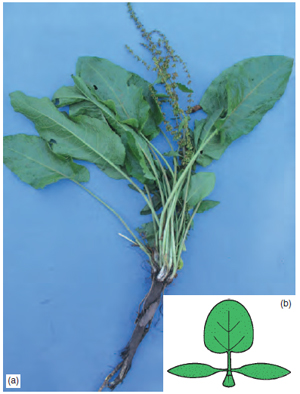Perennial weeds
Content
Five species (creeping thistle; couch; yarrow; dandelion and broad-leaved dock) are described below to demonstrate the different features of their biology (particularly the perennating organs) that make them successful weeds. The flowering period of these weeds is mainly between June and October (see Figure 13.10), but the main problem for gardeners and growers is the plant’s ability to survive and reproduce vegetatively. Creeping thistle (Cirsium arvense). Plant family – Asteraceae (Compositae)
Life cycle: The seedling cotyledons are broad and smooth, the true leaves are spiky (see Figure 13.11). The mature plant is readily recognizable by its dark green spiny foliage growing up to 1 m in height. It is found in all areas, even at altitudes of 750 m, and on saline soil. The species is dioecious, the male plant producing spherical and the female slightly elongated purple flower heads from July to September. Only when both sexes of the plant are within about 100 m of each other does fertilization occur in sufficient quantities to produce large numbers of brown, shiny fruit, 4 mm long. The seeds may germinate beneath the soil surface in the same year as their production, or in the following spring, particularly when soil temperatures reach 20°C. The resulting seedlings develop into a plant with a taproot which commonly reaches 3 m down into the soil. Spread: Seeds are wind-borne using a parachute of long hairs. The mature plant produces lateral roots which grow out horizontally about 0.3 m below the soil surface and may spread the plant as much as 6 m in one season. Along their length adventitious buds are produced that, each spring, grow up as stems. Under permanent grassland, the roots may remain dormant for many years. Soil disturbance, such as ploughing, breaks up the roots and may result in a worse thistle problem. Control: The seedling stage of this weed is not normally targeted by the gardener/grower. The main control strategy is primarily against the perennial root system. For both amateur and professional horticulturalist, cutting down plants at the flower bud stage when sugars are being transferred from the roots upwards is a physical control measure that partly achieves this objective. The amateur gardener can use another physical control, removing roots by deep digging. The amateur gardener is also able to use herbicide products which contain a mixture of dicamba, MCPA and mecoprop-P (all of these are translocated down to the roots). The professional grower can use the technique of deep ploughing to expose and dry off roots. Products containing the three active ingredients mentioned in the last paragraph are also available to the professional. Effectiveness of herbicide translocation to the roots is greatest when applied in autumn, at a time when plant sugars are similarly moving down the plant. Couch grass (Agropyron repens). Plant family – Poaceae (Graminae) Damage: This grass, sometimes called ‘twitch’, is a widely distributed and important weed found at altitudes up to 500 m. It is able to quite rapidly take over plots growing ornamentals, vegetables or fruit.
Spread: Couch seeds may be carried in grass seed batches over long distances. From May to October, stimulated by high light intensity, overwintered plants produce horizontal rhizomes (see Figure 13.12) just under the soil; these white rhizomes may spread 15 cm per year in heavy soils, 30 cm in sandy soils. They bear scale leaves on nodes that, under apical dominance, remain suppressed during the growing period. In the autumn, rhizomes attached to the mother plant often grow above ground to produce new plants that survive the winter. If the rhizome is cut by cultivations such as digging or ploughing, fragments containing a node and several centimetres of rhizome are able to grow into new plants. The rapid growth and extension of couch plants provides severe competition for light, water and nutrients in any infested crop.
The amateur gardener can use the herbicide, glufosinateammonium plus fatty acids for control in such situations as ornamental beds containing woody perennials and in cane fruit. For the professional horticulturalist, a translocated herbicide such as glyphosate, sprayed onto couch in fallow soils during active weed vegetative growth, kill most of the underground rhizomes. In established fruit, glufosinate-ammonium is recommended. Yarrow (Achillea millifolium). Plant family – Asteraceae (Compositae) Damage: This strongly scented perennial, with its spreading flowering head (Figure 13.13), is a common hedgerow plant found on most soils at altitudes up to 1200 m. Its persistence, together with its resistance to herbicides and drought in grassland, makes it a serious turf weed.
Life cycle: The seedling leaves are hairy and elongated, with sharp teeth (Figure 13.3). The mature plant has dissected pinnate leaves produced throughout the year on wiry, woolly stems, which commonly reach 45 cm in height, and which from May to September produce flat-topped white-to-pink flower heads. Each plant may produce 3000 small, flat seeds annually. The seeds germinate on arrival at the soil surface. Spread: Seeds are dispersed by birds. When not in flower, this species produces below-ground and above-ground stolons which can grow up to 20 cm long per year. In autumn, rooting from the nodes occurs. Control: Control of this weed may prove difficult. Routine scarification of turf does not easily remove the roots. For the amateur and professional, products containing 2,4-D and mecoprop are used against yarrow. Dandelion (Taraxacum officinale). Plant family – Asteraceae (Compositae) Damage: This species is a perennial with a stout taproot. It is a weed in lawns (see Figure 13.14), orchards and on paths. Several similar species such as mouse-ear hawkweed (Hieracium pilosella) and smooth hawk’s beard (Crepis capillaris) present problems similar to dandelion in turf. Life cycle: Seedlings emerge mainly in March and April. Flowers are produced from May to October. An average of 6000 seeds is produced by each plant. Most seeds survive only one year in the soil, but a few may survive for five years. Mature plants can survive for 10 years. Spread: Seeds are wind dispersed by means of tiny ‘parachutes’ and may travel several hundred metres. They are also able to spread in the moving water found in ditches and by animals through their digestive systems. The plant may regenerate from roots, after being chopped up by spades or rotavators. Control: Physical removal of the deep root by a sharp trowel is recommended, but this leaves bare gaps in turf for invasion by other weeds. For the amateur gardener and professional groundsman, products containing the two translocated ingredients, 2,4-D and dicamba , are able to kill the stout penetrating root of the dandelion. Broad-leaved dock (Rumex obtusifolius). Plant family – Polygonaceae Damage: This is a common perennial weed of arable land, grassland and fallow soil.
Spread: The numerous plate-like fruits (3 mm long) may fall to the ground or be dispersed by seed-eating birds such as finches. They are sometimes found in batches of seed stocks. Control: High levels of seed production, a tough taproot and a resistance to most herbicides present a problem in the control of this weed. For the amateur gardener, in turf, physical removal of the deep root by a sharp trowel is recommended, but this leaves bare gaps in turf for invasion by other weeds. A product containing dicamba, MCPA, and mecoprop-P is effective against young plants. For the professional horticulturalist, attempts in fallow soils to exhaust the root system by repeated ploughing and rotavating have proved useful. Young seedlings are easily controlled by translocated chemicals such as 2,4-D, but the mature plant is resistant to all but a few translocated chemicals, e.g. asulam, which may be used on grassland (not fine turf), soft fruit, top fruit and amenity areas, during periods of active vegetative weed growth when the chemical is moved most rapidly towards the roots. Mixed weed populations In the field a wide variety of both annual and perennial weeds may occur together. The horticulturalist must recognize the most important weeds in their holding or garden, so that a decision on the precise use of chemical control with the correct herbicide is achieved. Particular care is required to match the concentration of the herbicide to the weed species present. Also, the grower must be aware that continued use of one chemical may induce a change in weed species, some of which may be tolerant to that chemical. |
||||||||||||||||||||||||||||||||||||
